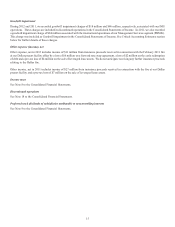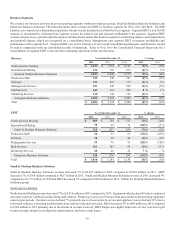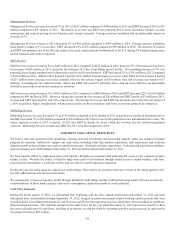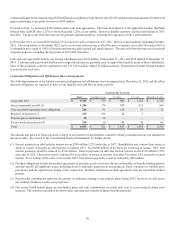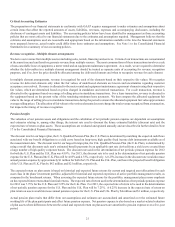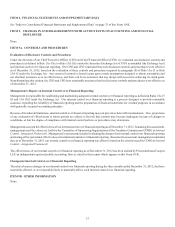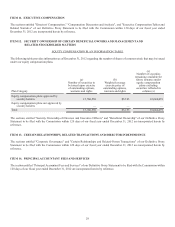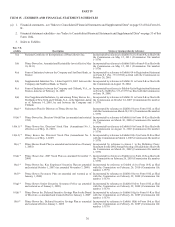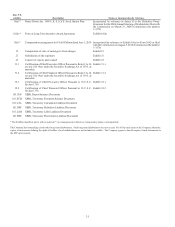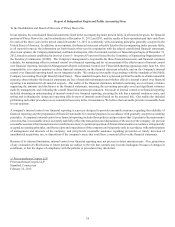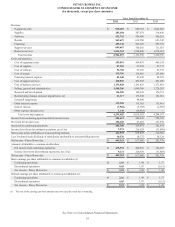Pitney Bowes 2012 Annual Report Download - page 43
Download and view the complete annual report
Please find page 43 of the 2012 Pitney Bowes annual report below. You can navigate through the pages in the report by either clicking on the pages listed below, or by using the keyword search tool below to find specific information within the annual report.25
Loss contingencies
In the ordinary course of business, we are routinely defendants in, or party to, a number of pending and threatened legal actions. On a
quarterly basis, we review the status of each significant matter and assess the potential financial exposure. If the potential loss from any
claim or legal action is considered probable and can be reasonably estimated, we establish a liability for the estimated loss. The assessment
of the ultimate outcome of each claim or legal action and the determination of the potential financial exposure requires significant
judgment. Estimates of potential liabilities for claims or legal actions are based only on information that is available at that time. As
additional information becomes available, we may revise our estimates, and these revisions could have a material impact on our results
of operations and financial position.
Legal and Regulatory Matters
Legal
See Legal Proceedings in Item 3 for information regarding our legal proceedings.
Other regulatory matters
As is the case with other large corporations, we are continually under examination by tax authorities in the United States, other countries
and local jurisdictions in which we have operations. The years under examination vary by jurisdiction. Except for a dispute arising out
of a partnership investment, the IRS examinations of tax years prior to 2009 are now closed to audit. We have other domestic and
international tax filings currently under examinations or subject to examination. Tax reserves have been established which we believe
to be appropriate given the possibility of tax adjustments. However, the resolution of such matters could have a material impact on our
results of operations, financial position and cash flows. See Note 8 to the Consolidated Financial Statements.
We are currently undergoing unclaimed property audits, which are being conducted by various state authorities. The property subject to
review in this audit process generally includes unclaimed wages, vendor payments and customer receipts. State escheat laws generally
require entities to report and remit abandoned and unclaimed property. Failure to timely report and remit the property can result in the
assessments of additional escheat liability, interest and penalties. It is too early to determine the ultimate outcome of such audits.
Foreign Currency Exchange
Over the last three years, approximately one-third of our consolidated revenue was derived from operations outside of the United States.
The functional currency for most of our foreign operations is the local currency. Our largest foreign currency exposure is to fluctuations
in the British pound, Euro and Canadian dollar, and to a lesser extent, the Australian dollar. Changes in the value of the U.S. dollar
relative to the currencies of countries in which we operate impact our reported assets, liabilities, revenue and expenses. Exchange rate
fluctuations can also impact the settlement of intercompany receivables and payables between our subsidiaries in different countries. For
the years ended December 31, 2012, 2011 and 2010, currency rate movements increased/(decreased) revenue by (1.2)%, 1.6% and 0.4%,
respectively. Based on the revenue contribution from our international operations in 2012, a 1% increase in the value of the U.S. dollar
would have reduced revenue by $15 million.
We use foreign exchange contracts to mitigate the risk of foreign currency exchange rate fluctuations. We enter into foreign exchange
contracts with only those financial institutions that meet stringent credit requirements as set forth in our derivative policy to mitigate our
exposure to counterparty credit risk. We regularly review our credit exposure balances as well as the creditworthiness of our counterparties.
Maximum risk of loss on these contracts is limited to the amount of the difference between the spot rate at the date of the contract delivery
and the contracted rate. At December 31, 2012, the fair value of our outstanding foreign exchange contracts was a net asset of $1 million.


